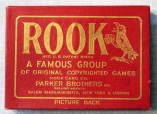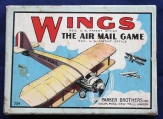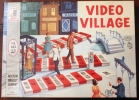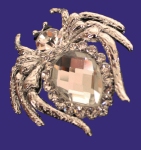As my partner Dan and I here at Dogbotz Boneyard have been preparing for the 2014 holiday season, which for us extends from Halloween to New Year’s Day and sometimes even to Martin Luther King, Jr.’s birthday, we have been posting new antique, vintage and even some contemporary products for resale. All of which led to my longtime friend Steve to ask me recently via e-mail, “Patrick, I am always amazed at the vintage board, card and even dice games you have available through Dogbotz Boneyard. Of all the games you personally collect or sell, which game companies and their products are your favorite to collect?”
Please be aware that Steve and I were colleagues back in the day (that would be the 1980s) when we both worked as fantasy role-playing game editors for TSR, Inc., the then-producer of Dungeons & Dragons and its various offspring. Even though I worked for TSR, Inc., and even though I believe the company was quite innovative when it came to role-playing games, it isn’t, alas, one of my all-time favorite game companies from which to collect product. As I had to play too many diverse roles (some good, others absolutely bizarre) in my real life, I didn’t (and still don’t) need more roles to play during my leisure moments.
That said, here are my four favorite games companies and some of the games they have created, manufactured, and distributed throughout the years.
Parker Brothers: A Philosophy of Entertainment
Since 1883, Parker Brothers has published more than 1,800 games. Among its best-known products are Monopoly, Sorry!, Risk, Trivial Pursuit, Ouija, and Probe. Of these, I would say that the finance-based, land baron game of Monopoly, which originated and gained in popularity during the Great Depression, has been the most enduring game ever produced during the Industrial Era and continues to sell well in this new millennium. It is the perennial favorite of board games and it is the most mimicked and reproduced game of the last century. If you doubt this, just go to the Internet and check out CafePress or CustomopolyGames. The royalties on this game’s patent most be enormous and blissfully ironic considering the board game’s financial focus.
For a bit of history, Parker Brothers was founded in Salem, Massachusetts by George S. Parker, whose philosophy deviated from the prevalent theme of board game design. George Parker believed that games should be played for enjoyment and did not need to emphasize morals and values. Hence, it is no surprise that he created his first game, Banking (in 1883 at the age of 16), which allowed players to borrow money from the bank and try to generate wealth by guessing how well they could do. There you go — there’s a little bit of the gambler or the hedge man in each of us, even when we play games!
In 1906, Parker Brothers published the game Rook, its most successful card game to this day, and it quickly became the best-selling game in the country. From the 1930s on, the company continued its phenomenal growth, producing such long-lasting popular board games as the murder mystery challenge of Clue, the military conquest inherent in Risk, and the family entertainment factor of Sorry!
In 1991. Hasbro acquired the rights of all Parker Brothers games and has, since 2013, phased out all references to Parker Brothers on its games. Too bad, in my opinion, Hasbro just doesn’t possess the same notable name recognition value or inventiveness of George Parker and his brothers.
Samples of Parker Brothers games sold through Dogbotz Boneyard:
The Milton Bradley Company: Friend to Mid-Century Television Shows
Just in case you didn’t know, the Milton Bradley Company was established as a game company in Springfield, Massachusetts in 1860 by Milton Bradley. In 1920, the company absorbed the game production of McLoughlin Brothers, formerly the largest game manufacturer in the United States; and, in 1987, it purchased Selchow and Righter, the makers of Parcheesi and Scrabble. Just like its arch-rival of many years, Parker Brothers, Milton Bradley was taken over by Hasbro, Inc., in 1984.
Regardless of its ultimate fate, The Milton Bradley Company was excellent at pursuing television production companies to acquire the titles of many television shows of the 1950s and 1960s that had name recognition for and were endearing to those of us who grew up as part of the “Baby Boom Generation.” But, in truth, Milton Bradley was a board game designer who made his money by making games that people enjoyed playing. Thus, when television became the technological marvel of the mid-20th century, Bradley’s design philosophy extended to the products of that medium. The list of television-based board or card games produced by The Milton Bradley Company is exhaustive, and just looking at what we have on sale at Dogbotz Boneyard, the list includes Annie Oakley, Captain Kangaroo, Charlie Brown, Johnny Quest, Lost in Space, Sergeant Preston, Video Village, Voyage to the Bottom of the Sea and Yogi Bear.
Of course, beyond the realm of television shows or Saturday morning cartoons, The Milton Bradley Company is also well known for some of its perennial family games such as Candy Land, Game of the States and Rack-o, not to mention its revered American Heritage set of four military history games: Broadside, Civil War, Dogfight and Hit the Beach.
Despite its acquisition by Hasbro, Inc., the Milton Bradley name has become synonymous with a game manufacturer that continues to turn out games that capitalized on current trends.
Here’s just a sampling of The Milton Bradley Company games we have on sale at Dogbotz Boneyard:
Ed-U-Cards Manufacturing Corporation: A Boomer’s Delight
As I approach my sixth decade of life, I remember that, as a kid growing up from the mid-1950s to the early 1970s, we had no such entertainment venues as video or online games. Yup, if my brother and I weren’t out riding our bicycles, playing sports, or having our G.I. Joes attack the prim-and-proper Ken dolls (our arch-rivals for Barbie’s affections) of our neighbor Holly Householder or other such prepubescent playtime activities, we were indoors, playing games. And, our favorites were produced by one of the nation’s most well-regarded educational game companies, Ed-U-Cards Manufacturing Corporation.
The Ed-U-Cards Manufacturing Corporation was originally located in Long Island City, New York and began operations in 1946 as a manufacturer of educational flash cards and card games. The late 1940s was an ideal time to start a new publishing company, as the paper rationing of World War II had recently ended. Many new magazines, local newspapers, catalogs, and other paper products started then, as the paper mills suddenly had lots of paper available, and that meant low prices.
Though Ed-U-Cards did produce cards for sheer entertainment value, such as its popular series of card games based on children’s televised cartoon shows like Huckleberry Hound, Quick Draw McGraw, Yogi Bear and The Flintstones, it most distinguished products were its educational games. Some of these were flash-card type games (for example, Tree Spotter Cards and Bible Story Cards), some focused on the fundamentals of language arts or mathematics (ABC Educational Cards and Animal, Bird, Fish Card Game come readily to mind), and others taught the basic of science or sports (Ed-U-Cards’ 1957 Baseball Card Game and, from the same year, Space Race Card Game are notable examples). Whatever games the company produced, these products were highly regarded and valued by us Boomer children as well as our parents and teachers.
Sadly, I could find no references to Ed-U-Cards Manufacturing Corporation beyond 1984. Nonetheless, the impact of the high-quality educational and entertainment games this firm produced lives on, for, in fact, today the industry term ed-u games refers to the production of the most visionary and enjoyable educational game products possible.
Here are some personal favorites we’ve made available through Dogbotz Boneyard:
Outset Media Corporation: Fast Forward to the Future
As a collector and seller of antique and vintage games, I also like to contemplate what contemporary board and card games might become long-lasting and noteworthy collectibles in the future. Though TSR, Inc., and its products might have been part of my favorites list, if there’s anything that I perceive as truly collectible about these games and their by-products, it’s their stunning color artwork. So, that’s why, for example, I have a Larry Elmore painting hanging in my home as part of my larger art collection (but science fiction and fantasy artwork is a topic for a future blog). Afterward, I considered the collectible card games produced by Wizards of the Coast, particularly Magic: The Gathering and its ilk. Yet, though they present intriguing content and game mechanics, these games struck me as a passing fad, albeit a huge revenue-generating one for its parent company.
No, I sought something more enduring, perhaps even of solid educational value such as the diverse games produced by Ed-U-Cards during my youth. And so, as I reviewed contemporary game companies and their products, the one that came immediately to mind was Outset Media Corporation, makers of the now-popular Professor Noggin’s series of educational card games, the first of which was produced in 2002.
Founded in 1996 by 23-year-old university student David Manga, Outset Media Corporation is a Canadian company that develops and distributes family entertainment products, specializing in board games, party games, card games, and jigsaw puzzles. The company was originally incorporated for the sole purpose of publishing and distributing a single board game called All Canadian Trivia, which was released in May 1997 and became a Canadian bestseller with more than 100,000 copies sold in Canada alone.
Then in 2002, a children’s educational card game phenomenon that featured the fictional instructor Professor Noggin was produced. Today, 39 different titles form part of the Professor Noggin’s series of card games, and over 800,000 copies have been sold worldwide. In addition, the series has garnered 14 international toy and game awards to date, and this acclaim is due to the fact that each card game in the series encourages children to learn interesting facts about their favorite subjects. Each game of 30 cards combines trivia, true-false, and multiple-choice questions. Each card set includes a special 3-numbered die to create interaction and promote communication between players. Easy and hard levels of testing knowledge keep children interested and challenged while having fun.
Try out one of the Professor Noggin’s card games with your children or even adult family members and friends, and you’ll see why I’ve add Outset Media Corporation to my list of all-time favorite game companies.
Dogbotz Boneyard offers many titles of in the Professor Noggin’s card game series; here are but a few:
Now it’s your turn! Tell me what game companies are your favorites, and why!
All the best,
Patrick Price,
Proprietor,
Dogbotz Boneyard, LLC
www.dogbotz.com










































